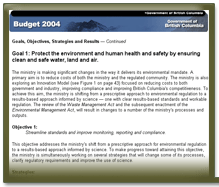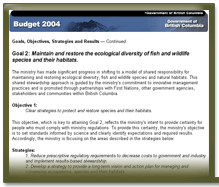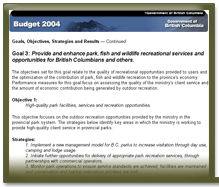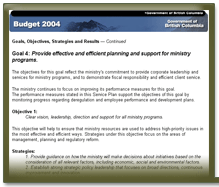 |
|
Goals, Objectives, Strategies and ResultsFor each core business area, a goal — a statement of general intent that directly supports the achievement of the ministry's vision and mission (see Appendix 1) — defines what the ministry wants to accomplish in that area of endeavour over the long term. In support of each goal, the ministry sets specific objectives. Objectives are statements that define the broad areas in which the ministry will focus and invest. They are based on direction received from the Core Review process. The specific actions or activities required to turn objectives into reality (such as implementation of a new approach to deal with a problem) are called strategies. Depending on resource capacity and management priorities, some strategies receive greater focus than others in some years. Underlying the delivery of each of the strategies are ongoing operational priorities and key projects that are critical to achieving the ministry's mandate, addressing government priorities and accomplishing strategic shifts (see Appendix 1). To answer the questions "Are the actions having the desired effect?" and "Are the objectives and goals being met?" The ministry adopts a balanced portfolio of performance measures (including outcome, output and efficiency measures).1 The components of the business planning/budgeting/performance reporting cycle are closely integrated. As a result, when an objective is revised or replaced (e.g., to better reflect the link between what the ministry is doing and the government's strategic direction), so must the strategies and performance measures associated with it be revised or replaced. This is the cycle of continuous improvement that underpins both effective public service planning and meaningful, accountable public performance reporting. The information below presents the objectives, strategies, key projects and performance measures for each of the ministry's goals. Each performance measure is linked to the ministry objective it assesses, and the rationale for the choice of each measure is explained.
|
|||||||||||||||||||||||||||||||||||||||||||||||||||||||||||||||||||||||||||
|
||||||||||||||||||||||||||||||||||||||||||||||||||||||||||||||||||||||||||||




